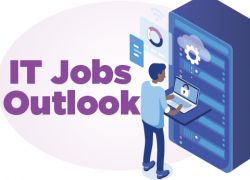
Interested in a fast-growing, high-wage career? In celebration of National Technology Day on Jan. 6, we’re highlighting growing occupations that focus on technology’s framework: data.
From 2021 to 2031, employment in the nine occupations shown below is projected to grow more rapidly than the average for all occupations (5.3%); in fact, most are expected to have much faster than average growth. Overall, the increases are projected to create nearly 300,000 new jobs over the decade.
What’s more, the median annual wage for each of these occupations was higher than the median annual wage of $45,760 for all occupations in May 2021. To enter any of these occupations, you’ll need at least a bachelor’s degree.
Actuaries use mathematics, statistics, and financial theory to analyze the economic costs of risk and uncertainty.
Projected employment growth, 2021–31: 20.8% (much faster than average)
Number of jobs, 2021: 28,300
Occupational openings, projected 2021–31 annual average: 2,400
Median annual wage, 2021: $105,900
Typical entry-level education: Bachelor's degree
Database architects design and build new databases for systems and applications.
Projected employment growth, 2021–31: 10.3% (faster than average)
Number of jobs, 2021: 52,700
Occupational openings, projected 2021–31 annual average: 11,500
Median annual wage, 2021: $123,430
Typical entry-level education: Bachelor's degree
Data scientists use analytical tools and techniques to extract meaningful insights from data.
Projected employment growth, 2021–31: 35.8% (much faster than average)
Number of jobs, 2021: 113,300
Occupational openings, projected 2021–31 annual average: 13,500
Median annual wage, 2021: $100,910
Typical entry-level education: Bachelor's degree
Economists collect and analyze data, research trends, and evaluate economic issues for resources, goods, and services.
Projected employment growth, 2021–31: 5.7% (as fast as average)
Number of jobs, 2021: 16,900
Occupational openings, projected 2021–31 annual average: 1,400
Median annual wage, 2021: $105,630
Typical entry-level education: Master's degree
Logisticians analyze data to coordinate an organization’s supply chain.
Projected employment growth, 2021–31: 27.7% (much faster than average)
Number of jobs, 2021: 195,000
Occupational openings, projected 2021–31 annual average: 24,800
Median annual wage, 2021: $77,030
Typical entry-level education: Bachelor's degree
Market research analysts study consumer preferences, business conditions, and other data to assess potential sales of a product or service.
Projected employment growth, 2021–31: 19.0% (much faster than average)
Number of jobs, 2021: 792,500
Occupational openings, projected 2021–31 annual average: 99,800
Median annual wage, 2021: $63,920
Typical entry-level education: Bachelor's degree
Operations research analysts use mathematics and logic to help solve complex issues.
Projected employment growth, 2021–31: 23.2% (much faster than average)
Number of jobs, 2021: 104,200
Occupational openings, projected 2021–31 annual average: 10,300
Median annual wage, 2021: $82,360
Typical entry-level education: Bachelor's degree
Statisticians analyze data or apply mathematical theory to provide usable information.
Projected employment growth, 2021–31: 32.7% (much faster than average)
Number of jobs, 2021: 34,200
Occupational openings, projected 2021–31 annual average: 3,900
Median annual wage, 2021: $95,570
Typical entry-level education: Master's degree
Survey researchers design and conduct surveys and analyze data.
Projected employment growth, 2021–31: 6.3% (as fast as average)
Number of jobs, 2021: 10,400
Occupational openings, projected 2021–31 annual average: 1,000
Median annual wage, 2021: $59,740
Typical entry-level education: Master's degree
You can explore these and hundreds of other occupations in the Bureau of Labor Statistics Occupational Outlook Handbook.
Ryan Farrell and Maria Hussain are economists in the U.S. Bureau of Labor Statistics. Follow BLS on Twitter at @BLS_gov.

 U.S. Department of Labor Blog
U.S. Department of Labor Blog



